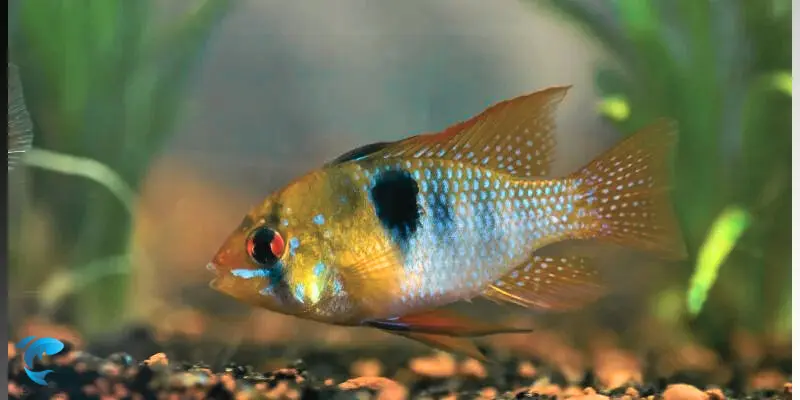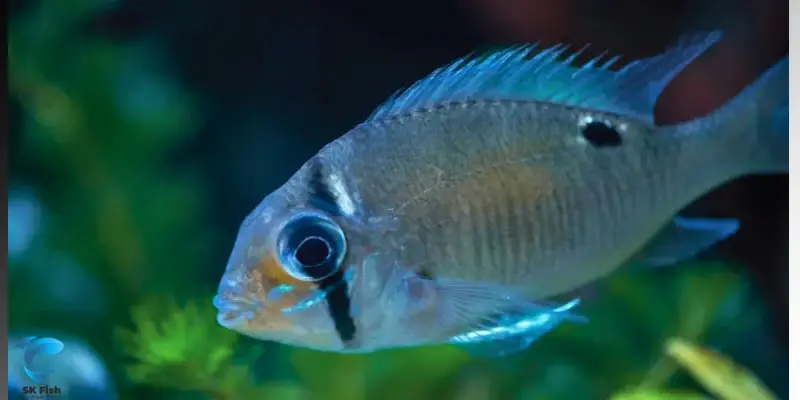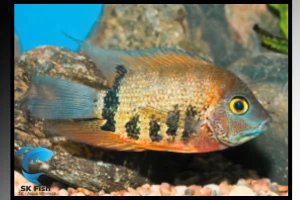Keyhole Fish | Your Complete Care Guide & Aquarium Companion
Published: 5 Apr 2024
Welcome to the captivating realm of keyhole fish! In this blog, we delve into everything you need to know about these charming cichlids, known for their distinctive keyhole-shaped markings.
Curious about caring for keyholes in captivity? You’ve come to the right place! Join us as we explore a comprehensive guide to this remarkable species. Let’s dive in!
What is Keyhole Fish?
Keyhole fish, scientifically known as “Cleithracara maronii”, are charming freshwater cichlids cherished by aquarium enthusiasts worldwide. Whether you’re a seasoned aquarist or a beginner, these species make an excellent choice for your aquarium.

Common Names
Keyhole cichlids have various names some are listed below:
- Keyhole cichlid
- Maronii cichlid
- African Keyhole cichlid
- Cleithracara Maronii
- Acara Maronii
- Maron’s Acara
Size and Weight
Similar to other fish species, the size and weight of keyhole cichlids are influenced by factors such as age, diet, and environmental conditions. Typically, keyhole cichlids reach a size of 4 to 5 inches and weigh between 30 to 60 grams when fully mature.
Lifespan and Reproduction
Keyhole cichlids typically have an average lifespan of 8 to 10 years in captivity, which can be extended with proper care.
When it comes to reproduction, keyhole cichlids are egg-laying species. Females deposit their eggs on a flat surface, after which both male and female keyhole cichlids guard them. The parents protect the eggs and fry until they can fend for themselves, ensuring the next generation’s survival.
Aquarium Care Guide for Keyhole Fish
Are you intrigued by the prospect of keeping the captivating keyhole fish in your aquarium? Look no further! In this comprehensive care guide, we’ll delve into everything you need to know about caring for these fascinating creatures in captivity. Let’s dive in!
Tank Size
The size of your aquarium plays a crucial role in providing adequate space for a couple of pairs of keyhole cichlids. A minimum tank size of 25 gallons is recommended to accommodate their active behavior and ensure they have enough room to swim freely.
Tank Decor
Create an aesthetically pleasing environment for your keyhole cichlids by decorating their tank with live rocks, plants, and substrates. These elements not only enhance the beauty of the tank but also provide essential hiding spots for the fish. Hiding spots are particularly important for breeding and ensuring the well-being of your keyhole cichlids.

Water Parameters
Ensuring optimal water quality is crucial for the health of your keyhole fish. Regularly perform water changes and monitor levels of nitrate and ammonia to keep them within safe limits. Aim for a pH level between 6.4 to 7.6 and maintain a temperature range of 70 to 80 degrees Fahrenheit to create a conducive environment for your keyhole fish.
Tank Mates
Keyhole fish are known for their peaceful and calm demeanor, making them excellent additions to community aquariums. They can coexist harmoniously with other peaceful species such as lyonsi cichlids, dwarf cichlids, and rasboras. However, it’s crucial to avoid pairing them with aggressive species to maintain a tranquil environment in the tank.
Diet for Keyhole Fish
A balanced diet is essential for the health of keyhole fish, as they are omnivores that require a varied diet to thrive.
| Diet |
|---|
|
Tips for Breeding
Breeding keyhole fish is indeed a straightforward process. To encourage breeding, it’s essential to set up the tank with ample hiding places and flat surfaces.
Female keyholes typically lay their eggs on flat surfaces, and the male keyhole guards them until they hatch. Once the eggs hatch, it’s crucial to provide proper food for the fry. Feed them multiple times a day in small amounts until they can consume food independently. Keyhole fish exhibit excellent parental care, ensuring the fry’s well-being until they are self-sufficient.

Healthy and Sick Signs for Keyhole Fish
Just like any other fish, keyhole fish can encounter health issues. Therefore, every aquarist needs to be able to recognize signs of both health and sickness in keyhole fish.
Healthy Signs
| Healthy Keyhole Signs |
|---|
|
Sick Signs
| Sick Keyhole Signs |
|---|
|
Conclusion
In conclusion, we’ve delved into the fascinating world of keyhole fish, covering essential aspects such as their common names, sizes, weights, lifespans, reproduction, and comprehensive aquarium care guidelines. Additionally, we’ve explored breeding tips and learned to recognize both healthy and sick signs in these remarkable fish. I trust you found this blog insightful and enjoyable. Feel free to share your feedback in the comment section below.
FAQs
How big do keyhole fish get?
Keyhole fish are relatively small in size, with their dimensions influenced by factors such as age, diet, and care. Typically, when fully mature, they can reach lengths of 4 to 5 inches.
How do you take care of a keyhole cichlid?
Caring for keyhole cichlids is relatively straightforward and can be managed effectively by ensuring a well-equipped aquarium environment. This includes providing ample hiding spots, maintaining a varied and nutritious diet, and conducting regular water quality checks. With proper attention to these aspects, keyhole cichlids can thrive in captivity.
Which cichlid is not aggressive?
If you’re seeking non-aggressive cichlids for your aquarium, consider species like keyhole cichlids, lyonsi cichlids, electric cichlids, rusty cichlids, and others known for their peaceful and calm behavior. These cichlids can coexist harmoniously with other tank mates, contributing to a tranquil and balanced aquatic environment.
Are keyhole cichlid African?
No, the keyhole cichlid is not African. These species are native to South America, specifically found in the lower Amazon River basin and its tributaries. They are commonly found in countries like Brazil, Colombia, and Venezuela.

SK Fish is your trusted source for practical fish care tips and delicious seafood recipes. Our team is dedicated to providing reliable, well-researched content for fishing enthusiasts and home cooks alike.

- Be Respectful
- Stay Relevant
- Stay Positive
- True Feedback
- Encourage Discussion
- Avoid Spamming
- No Fake News
- Don't Copy-Paste
- No Personal Attacks



- Be Respectful
- Stay Relevant
- Stay Positive
- True Feedback
- Encourage Discussion
- Avoid Spamming
- No Fake News
- Don't Copy-Paste
- No Personal Attacks





